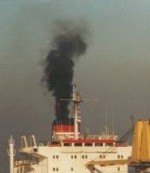 We have noted before the paradox of ocean shipping — it is simultaneously the most energy efficient means of transportation with the lowest carbon footprint while at the same time, it is a major polluter. (See our post from back in 2010 — Ocean Transportation – Beautifully Green or Murderously Dirty?) The problem is fuel. Most ships burn residual fuel which is the lowest cost but very dirty. Dirty fuel makes for dirty ships. Residual fuel, also know as Bunker C, 6 oil and HFO, is, however, slowly becoming a thing of the past. Phased restrictions on sulfur levels by IMO, the EPA and various other national regulatory agencies around the world are effectively forcing ship owners to use cleaner and more expensive fuels.
We have noted before the paradox of ocean shipping — it is simultaneously the most energy efficient means of transportation with the lowest carbon footprint while at the same time, it is a major polluter. (See our post from back in 2010 — Ocean Transportation – Beautifully Green or Murderously Dirty?) The problem is fuel. Most ships burn residual fuel which is the lowest cost but very dirty. Dirty fuel makes for dirty ships. Residual fuel, also know as Bunker C, 6 oil and HFO, is, however, slowly becoming a thing of the past. Phased restrictions on sulfur levels by IMO, the EPA and various other national regulatory agencies around the world are effectively forcing ship owners to use cleaner and more expensive fuels.
What is the fuel of the future? Is is merely lighter and more expensive oil distillates or something quite different?
Some argue that natural gas will be a major new fuel for future ocean shipping. In order to carry it on ships it must first be liquefied. Liquefied natural Gas (LNG) is 1/600th the volume of natural gas in the gaseous state. It also must be carried at near absolute zero — approximately −162 °C (−260 °F).
At first glance, notwithstanding the inherent problems with carrying such a cold and volatile liquid, LNG looks like an excellent marine fuel. It is currently less expensive than oil and has a much smaller carbon foot print when burned that fuel oil. How Liquid Natural Gas May Revolutionize Shipping, And Make Goods Cheaper
The DNV Report — Shipping 2020 predicts that LNG will power 30% of new ships by the year 2020.
The problem is that natural gas is mostly methane, which is a dangerous greenhouse gas. Methane is roughly 20 times more damaging than CO2. Methane leaks during the production, delivery and use of natural gas have the potential of negating any environmental benefit that burning the fuel may have.
The Navy recently announced that it has succeeded, at least on a trial basis, in synthesizing ships’ fuel from sea water. As reported by the International Business Times: The breakthrough came after scientists developed a way to extract carbon dioxide and hydrogen gas from seawater. The gasses are then turned into a fuel by a gas-to-liquids process with the help of catalytic converters.
“For us in the military, in the Navy, we have some pretty unusual and different kinds of challenges,” said Cullom. “We don’t necessarily go to a gas station to get our fuel. Our gas station comes to us in terms of an oiler, a replenishment ship. Developing a game-changing technology like this, seawater to fuel, really is something that reinvents a lot of the way we can do business when you think about logistics, readiness.”
The Navy currently estimates that the final cost of the synthetic fuel will be in the range of $3 — $6 per gallon, or $126 — $252 per barrel.
Whichever fuel is finally used, the era of cheap energy appears to be over. The last time energy was this expensive, on a BTU equivalent basis, was in the late 1800s. The largest bulk carriers on the oceans back then were iron and steel sailing ships. They were simply the lowest cost and most efficient vessels of their day. When the price of price of energy plummeted to an oil price of around $20 a barrel the sailing ships could no longer compete. We have witnessed roughly a century of cheap energy. Now that era appears to be over, the economics of commercial sail have become very attractive. In at least some shipping sectors, the “new” fuel of the future may be wind.
Thanks to Alaric Bond and Irwin Bryan for contributing to this post.

Read about ships going with LNG.
Also been reading about the builds or plans to build LNG terminals over in Europe, talk of Ukraine wanted one, which may have started the mess they are in now, not buying fuel from Russia.
Passing memory of Japan in the LNG market too, don’t remember if it was to build or expand.
Related:
Drilled, but too many gas wells and no where to put it.
(Just wait, they well find a place overseas, then we’ll need it and pay through the nose for it)
From geology web site:
A soultion for shut-in 1300 drilled and umcompleted gas wells in marcellus shale.
http://www.eia.gov/naturalgas/weekly/
Figured this would happen with Russia acting up, who also supplies Europe with gas.
March, 2014 article from Nat Geo
North American natural gas seaks markets overseas.
http://www.eia.gov/naturalgas/weekly/
Sorry, wrong link to Nat. Geo.
Here is where they talk of shipping LNG overseas.
http://news.nationalgeographic.com/news/energy/2014/03/140320-north-american-natural-gas-seeks-markets-overseas/
The first oceangoing LNG ship was the Methane Princess back in 1964. What is so new and unusual is that the US is now in a position to export LNG whereas it was previously only an importer.